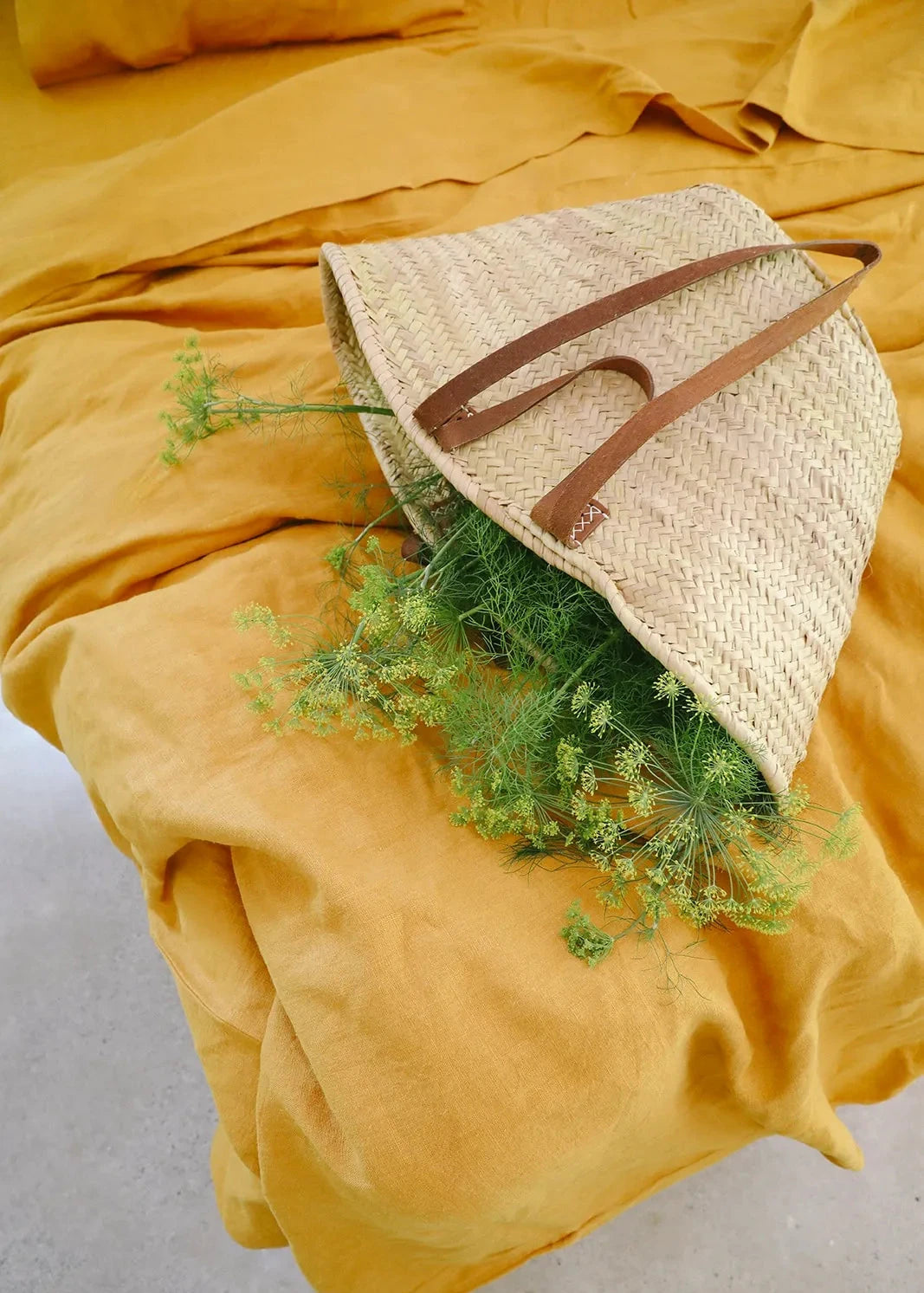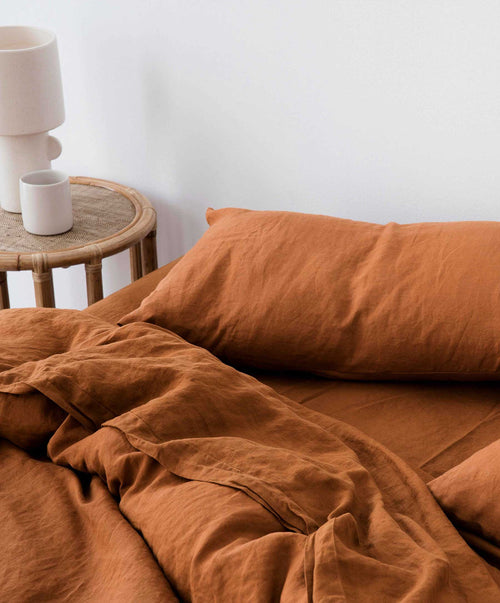What to Try to find When Picking Bed Linen: Crucial Tips to Make Certain High Quality and Sturdiness
Selecting the right linen needs a discerning strategy, as different variables dramatically influence both quality and durability (buy linen australia). Secret factors to consider consist of the kind of linen textile, the complexities of string matter, and the building of the weave. Additionally, the finishes applied can boost not just the aesthetic charm but likewise the textile's sturdiness and comfort. Comprehending these essential aspects will assist you in making educated selections. The nuances of sustainable sourcing and its impact on your options require additional expedition.
Recognizing Linen Kind
When choosing linen, it is essential to recognize the numerous types readily available, as each deals unique characteristics and advantages. Bed linen is largely stemmed from the flax plant, and its top quality can vary based upon the handling techniques and meant usage.

Cleaned bed linen, dealt with to accomplish a soft, unwinded appearance, has actually obtained popularity for its laid-back allure and comfort. Additionally, specialized linens, such as damask or jacquard, function complex patterns woven into the textile, adding a degree of class. buy linen australia. Understanding these types will make it possible for consumers to make informed choices that line up with their certain needs and preferences, guaranteeing the selection of top quality linen that improves both looks and functionality
Value of Thread Matter
Comprehending the importance of thread count is essential for choosing top notch linen, as it directly affects the fabric's feeling, sturdiness, and total efficiency. Thread count refers to the variety of threads woven together in a square inch of fabric, including both horizontal (weft) and vertical (warp) threads. Normally, a greater thread count suggests a denser, a lot more glamorous fabric that is frequently softer to the touch.

Nonetheless, it is important to recognize that thread count alone does not establish high quality. A sound linen with a moderate string count can outmatch a higher string matter material if the threads are of substandard high quality or the weave is not performed appropriately. For bed linen especially, an optimal string matter generally ranges from 180 to 300, stabilizing soft qualities and breathability without endangering toughness.
Furthermore, while greater string matters might suggest an extra luxurious fabric, they can sometimes lead to much less breathability, which is a necessary feature of linen. When picking bed linen, take into consideration the thread matter together with the quality of the fibers and the planned use of the fabric, ensuring that you accomplish the ideal balance for your demands.
Evaluating Weave Building And Construction

Simple weave, characterized by its simplicity and tight interlacing of strings, leads to a smooth and sturdy material. It is often preferred for day-to-day use due to its longevity and resistance to fraying. Twill weave, marked by its diagonal ribbing, boosts the textile's drape and gentleness, making it a preferred option for garments and bed linens that call for an even more glamorous feeling. Satin weave, while less common in bed linen, gives a glossy surface and boosted luster, appropriate for upscale products.
When evaluating bed linen, pay very close attention to the weave thickness; a tighter weave usually indicates a greater quality material that is much less vulnerable to tear and put on. Furthermore, take into consideration the weave's influence on breathability, as a sound bed linen should stay comfortable and airy, supplying both function and visual charm.
Analyzing Textile Surfaces
Examining textile finishes is important for ensuring the long life and visual charm of bed linen items. The finish of a linen textile can considerably influence its appearance, structure, and efficiency. Common surfaces include enzyme cleans, mercerization, and garment dyeing, each conveying special qualities to the material.
Enzyme cleans boost soft qualities and drape while decreasing creases, making the textile much more comfy to use and easier to maintain. Mercerization, a process that entails dealing with the linen with caustic soft drink, raises radiance and strength, resulting in a material that is site both visually enticing and durable. Garment dyeing, on the various other hand, enables for vibrant shades and deepness, providing an extra customized touch to the linen.
When evaluating finishes, take notice of the feel of the textile-- top quality finishes ought to yield a smooth, soft structure with no cruelty. Additionally, evaluate the color consistency and overall look; irregular coloring or fading may suggest substandard surfaces. Eventually, recognizing fabric finishes is vital in choosing linen that not only fulfills aesthetic preferences yet also assures long-lasting satisfaction and use.
Thinking About Sustainable Sourcing
Sustainable sourcing is a critical consider the bed linen industry, affecting both environmental impact and social duty. As customers end up being increasingly knowledgeable about ecological problems, the need for sustainably sourced bed linen has risen. This involves not only the growing of flax plants in environmentally-friendly means yet likewise honest labor methods throughout the supply chain.
When assessing linen products, try to find qualifications such as Continued the Worldwide Organic Fabric Requirement (GOTS) or the European Flax accreditation, which suggest accountable farming and production techniques. These qualifications make sure that the linen is made from natural fibers which strict environmental and social criteria are satisfied.
Furthermore, consider the geographical sourcing of linen. Bed linen produced in regions known for lasting farming techniques, such as Europe, usually supplies better quality and lower eco-friendly footprints contrasted to those sourced from less regulated areas.
Conclusion
In verdict, selecting high-grade bed linen involves cautious consideration of various factors, consisting of fabric type, string matter, weave construction, and coatings. Focusing on combined or pure bed linen with a suitable string matter improves convenience and resilience.
Secret factors to consider consist of the kind of bed linen material, the complexities of thread count, and the construction of the weave. linen.The most common types of linen consist of pure linen, mixed bed linen, and washed bed linen. Combined linen, which combines flax with various other fibers like cotton or polyester, offers increased gentleness and crease resistance, making it more easy to use while maintaining some of linen's inherent qualities
A well-constructed bed linen with a modest thread count can outperform a greater string matter fabric if the threads are of inferior top quality or the weave is not performed effectively.In conclusion, selecting top quality linked here linen entails cautious factor to consider of various aspects, including material type, thread matter, weave building, and finishes.